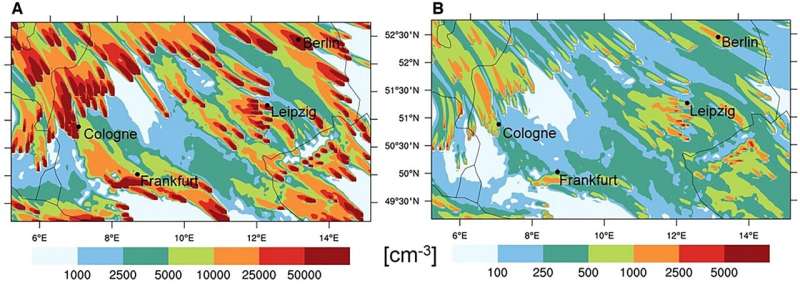Ultrafine atmospheric dust from exhaust gases of fossil fuels might cause weather extremes

Strong precipitation or extreme drought—the frequency of extreme weather events is increasing worldwide. Existing climate models, however, do not adequately show their dynamics. Researchers of Karlsruhe Institute of Technology (KIT) assume that ultrafine particles in the atmosphere have a significant impact on cloud physics and, hence, on weather. Their aircraft measurements confirm an increase in particle emissions in spite of a decreasing coarse fine dust concentration and blame it on the combustion of fossil fuels in exhaust gas cleaning systems. Their results are published in Scientific Reports.
According to latest reports of the Intergovernmental Panel on Climate Change, IPCC for short, weather extremes, such as droughts and strong precipitation, will increase in the future. “So far, climate researchers have attributed these changes to an increasing carbon dioxide concentration and the higher water vapor capacity of a warmer atmosphere,” says Dr. Wolfgang Junkermann from the Atmospheric Environmental Research Division of KIT’s Institute of Meteorology and Climate Research (IMK-IFU), KIT’s Campus Alpine in Garmisch-Partenkirchen. As carbon dioxide is homogeneously distributed in space due to its longevity, however, it does not sufficiently explain the variability of the distribution and occurrence of extreme weather events without taking into account the hydrological cycle, he adds.
Together with climate researcher Professor Jorg Hacker from the independent Airborne Research Australia (ARA) Research Institute, Junkermann argues that ultrafine particles from a few nanometers up to 100 nanometers in size are produced by the combustion of fossil fuels and significantly contribute to extreme weather events, because they act as condensation nuclei and have a regional, short-term impact on cloud physics.
“With conventional cloud formation models, we can show that the increase in ultrafine particles results in the formation of also particularly fine droplets,” Junkermann explains. “As a result, water stays much longer in the atmosphere, rain is initially suppressed, and an additional energy reservoir develops in the middle troposphere, which promotes extreme precipitation. It may happen hundreds of kilometers away. A heterogeneous distribution of nanoparticle pollution might explain the big regional differences of extreme weather events.”
Nanoparticles from modern exhaust gas cleaning
So far, the impact of ultrafine particles on cloud formation can be observed directly in very rare cases only. For this reason, the researchers used data on the amount and distribution of ultrafine dust in the Earth’s atmosphere and on changes of the hydrological cycle. They found that in many areas of the Earth, an increase in particle numbers correlates with regionally changed precipitation patterns.
“Over the Mediterranean Sea, for instance, particle concentration has increased by a factor of 25 since the 1970s,” Junkermann says. “In the same period, strong variations of precipitation can be observed with a decrease in regular rainfall and an increase in drought and extreme events.”
Similar patterns are encountered in Australia and Mongolia. This finding is based on extensive measurements with small airplanes that produced what is probably the biggest dataset of this type over a period of 20 years. The data cover historically reconstructable emissions and well-documented regional climate changes in areas of Asia, Central America, Europe, and Australia.
These data confirm an extreme increase in particle emissions since the 1970s. “At certain locations, we found up to 150,000 particles/cm³ compared to about 1,000 particles 40 years ago,” Junkermann says. “These extreme concentrations were attributed to power plants, refineries, or ship traffic and often and in particular to large incineration plants with latest exhaust gas technology.”
Since the 1990s, ammonia has been used to prevent the formation of nitrogen oxides (NOx) in exhaust gases of industrial facilities. The researchers associated this with the emission of many nanoparticles into the atmosphere.
In their article, the scientists call for a reconsideration of the increasing ultrafine dust concentration in the atmosphere for climate research scenarios. Calculations used so far have been based on dust values from emission scenarios of the beginning of the century. “Updated data will considerably improve modeling of the hydrological cycle, precipitation changes, and extreme weather events,” Junkermann says.
Power plants produce more ultrafine dust than traffic
Wolfgang Junkermann et al, Unprecedented levels of ultrafine particles, major sources, and the hydrological cycle, Scientific Reports (2022). DOI: 10.1038/s41598-022-11500-5
Citation:
Ultrafine atmospheric dust from exhaust gases of fossil fuels might cause weather extremes (2022, May 31)
retrieved 31 May 2022
from https://phys.org/news/2022-05-ultrafine-atmospheric-exhaust-gases-fossil.html
This document is subject to copyright. Apart from any fair dealing for the purpose of private study or research, no
part may be reproduced without the written permission. The content is provided for information purposes only.
For all the latest Science News Click Here
For the latest news and updates, follow us on Google News.

